|
Abstract 摘要
OCUS组被用来确定在美国南部森林生物量的利用率提高战略接触障碍的机会。该组是基于在生物基生物能源和产品价值链的七个关键部件,如确定的国际能源机构(IEA)生物能源任务31''从可持续林业生物质生产能源。“”这些组件包括可持续生物质生产,森林可持续经营,产品交付物流,制造业和能源生产,环境的可持续发展,消费需求和农村经济发展。与参加会人包括了各七个部分地区精心挑选的专家。六个共同主题焦点小组应运而生。创造市场,基础设施建设,社区参与,奖励,协作和教育都将生物质产业的成功发展至关重要。森林工业,能源工业,学术界,推广人员和农村社区应一起合作来支持研究,政策问题,以及加强当前森林生物量的运营效率,并促进生物能源利用森林生物量的教育计划。Focus groups were used to identify opportunities, barriers, and strategies for increased utilization of forest biomass in the Southern United States. The groups were based on the seven critical components in the bioenergy and bio-based products value chain, as identified by the International Energy Agency (IEA) Bioenergy Task 31 ‘‘Biomass Production for Energy from Sustainable Forestry.’’ These components include sustainable biomass production, sustainable forest operations, product delivery logistics, manufacturing and energy production, environmental sustainability, consumer demand, and rural economic development. Participants included handpicked experts from each of the seven component areas. Six common themes emerged from the focus groups. Market creation, infrastructure development, community engagement, incentives, collaboration, and education will all be critical to the successful development of the biomass industry. The forest industry, the energy industry, academia, extension personnel, and rural communities should collaborate together to support research, policy issues, and educational programs that enhance the efficiency of current forest biomass operations and promote the use of forest biomass for bioenergy. r 2007 Elsevier Ltd. All rights reserved.
1. Introduction 介绍
The forests of the Southern United States cover approximately 856,000 km2. Ninety-three percent of this land is classified by the USDA Forest Service as ‘‘timberland’’, or capable of producing a commercially viable timber crop. These forests cover 13 southern states including Alabama, Arkansas, Florida, Georgia, Kentucky, Louisiana, Mississippi, North Carolina, Oklahoma, South Carolina, Tennessee, Texas, and Virginia. While individual states have experienced changes in forested acres, the regional total has remained fairly steady over the last 30 years. Approximately 69% of the forest land is controlled by nonindustrial private landowners [1]. Since such a large portion of Southern US forests are privately owned, maintenance of productivity and sustainability of forest operations are very important. Several other factors provide stimuli for utilizing the forest biomass produced in the Southern United States. One such specific reason includes forest health. Natural disasters and pest outbreaks are common occurrences in the South. Hurricanes Rita and Katrina struck the Gulf Coast in 2005. Over 714 Gt (dry) of timber was damaged by just two storms [2,3]. The Southern pine beetle (Dendroctonus frontalis) also causes significant damage to Southern forests. On average, 1.23 Gt of biomass is killed annually by the beetle in 11 Southern states [4]. While the amount of timber damaged varies greatly, a significant source of nonmerchantable timber is created, which could be used for bioenergy and bio-based products. A second stimulus concerns rural economic development. The Southern United States is largely rural, with over 60% of the South’s counties and parishes considered rural in nature [5]. Forests serve as the economic base for 0961-9534/$ -see front matter r 2007 Elsevier Ltd. All rights reserved. doi:10.1016/j.biombioe.2007.06.021
C.A. Mayfield et al. / Biomass and Bioenergy 31 (2007) 631–637 many Southern rural areas. In 1997, the value of the Southern forest industry was estimated to be $8.3 . 1010 in total industry output [6]. Downturns in the pulp wood markets are causing many of these communities to struggle economically. A recent study [7] indicated that electricity generation solely from small-diameter trees and logging residue could generate $215 M in value added annually and generate 1340 new jobs in 43 East Texas counties. Development of this potential will help defray the costs of maintaining forest health, creating employment, and diversifying the economic structure of rural communities. While the benefits of utilizing forest biomass for bioenergy and bio-based products are numerous, industrial development has not been rapid. The purpose of the workshop described in this paper was to determine the current state of knowledge, opportunities, barriers, and actions for developing a more significant bioenergy and bio-based products industry in the Southern United States.
2. Methods 方法
In December 2004, 55 experts in renewable energy, economic development, forest management, and the forest products industry convened for a workshop in Houston, TX. The workshop was designed to discuss information related to the current state of the production and utilization of forest bioenergy in the Southern United States. Conference participants were handpicked by a steering committee of their peers and included national and regional leaders, industry leaders, and university personnel (Table 1).
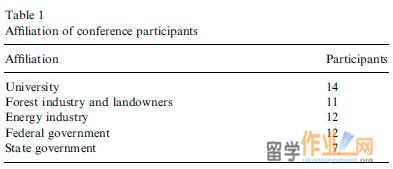
3. Critical components in the forest bio-based products value chain 森林生物基产品价值链中的关键组成部分
The workshop was developed around the seven critical components in the forest bioenergy and bio-based products value chain as identified by the International Energy Agency Bioenergy Task 31 (Fig. 1) [8]. These seven components include (1) sustainable biomass production, (2) sustainable forest operations, (3) product delivery logistics, (4) manufacturing and energy production, (5) environmental sustainability, (6) consumer demand, and (7) rural economic development. Day one of the conference was dedicated to presentations relating to the seven critical components of the sustainable bioenergy and bio-based products value chain. Table 1 Affiliation of conference participants Affiliation Participants University 14 Forest industry and landowners 11 Energy industry 12 Federal government 12 State government 7 Each speaker was asked to characterize the state of development in their assigned component of the value chain and identify technical and nontechnical barriers limiting deployment of the associated industries. This provided all participants with background material for each component and exposed work currently being done in each field. Following the presentations, participants were divided into focus groups to identify the current state of knowledge, opportunities, barriers, and actions to be taken for each component of the forest bio-based products value chain. The groups were asked to not only focus on their component but also to consider their component and its relationship with the integrated bioenergy value chain. For example, while the sustainable forest operations’ focus group was to discuss operations, the group was also asked to consider how operations relate to consumer demand and vice versa. The concept was to encourage the experts to think ‘‘outside the box’’ and look at their area of expertise from a different vantage point. Results from each of the focus groups were summarized, and are presented in the following section.
4. Results and discussion 结果与讨论
4.1. Critical component 1: sustainable biomass production
Issues related to research and development topped the list of barriers for the Sustainable Biomass Production focus group (Table 2).
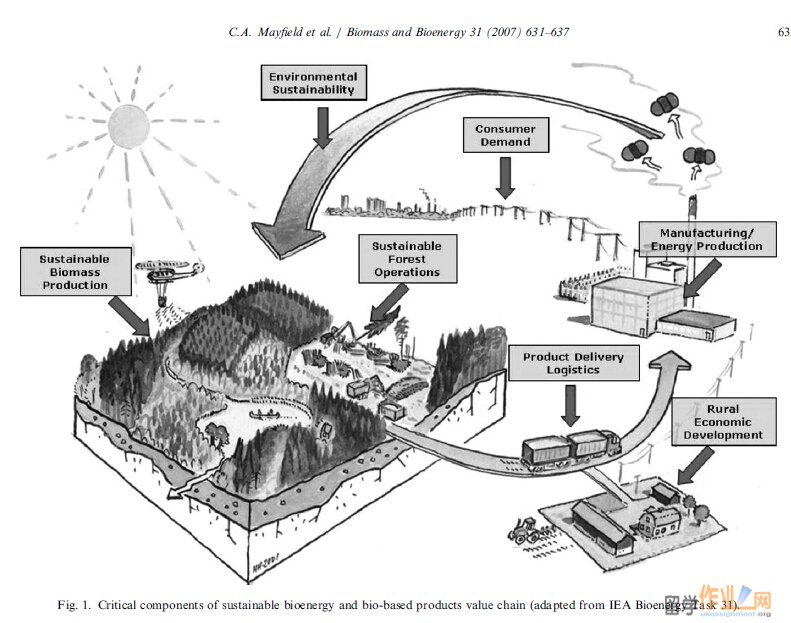 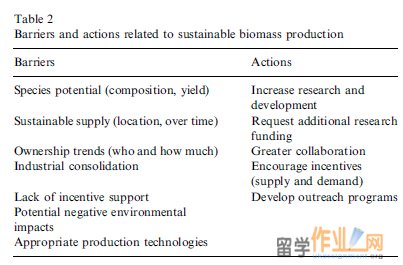 The potential relative value of different species to the bioenergy and bio-based products sector was a key barrier identified by the group. Other barriers included feedstock availability and cost competitiveness of forest biomass as a feedstock. The availability of appropriate production technologies, industry consolidation, and potential negative environmental impacts were also identified as barriers. Lack of incentives for landowners, consumers, and business development was another issue identified by the group. Actions included a focus on increased research and development, funding, and collaboration. Research should be conducted relative to cost competitiveness, landowner attitudes, and analysis of existing policy and programs related to bioenergy and bio-based products. In order to facilitate this research, additional funding should be sought under the Healthy Forests Restoration Act of 2003 (http:// www.theorator.com/bills108/hr1904.html), the Energy Policy Act of 2005 (http://thomas.loc.gov/cgi-bin/query/ z?c109:H.R.6.ENR:), and the Farm Security and Reinvestment Act of 2002 (http://www.ers.usda.gov/Features/ FarmBill/2002FarmAct.pdf). This research should be conducted with a spirit of collaboration and should include academic institutions, federal and state government agencies, and the business community. In addition, educational programs should be designed to introduce consumers to the research currently being done and to the possibility of #p#分页标题#e#
C.A. Mayfield et al. / Biomass and Bioenergy 31 (2007) 631–637 Fig. 1. Critical components of sustainable bioenergy and bio-based products value chain (adapted from IEA Bioenergy Task 31). Table 2 Barriers and actions related to sustainable biomass production Barriers Actions Species potential (composition, yield) Increase research and development Sustainable supply (location, over time) Request additional research funding Ownership trends (who and how much) Greater collaboration Industrial consolidation Encourage incentives (supply and demand) Lack of incentive support Develop outreach programs Potential negative environmental impacts Appropriate production technologies using forest resources for bioenergy and bio-based products.
4.2. Critical component 2: sustainable forest operations
Production economics, marketing, public perception of the forestry industry along with logging capacity were the Table 3 Barriers and actions related to sustainable forest operations Barriers Actions Economically competitive feedstocks Increase operational efficiency Lack of adequate markets Encourage capital investment Public perception Develop outreach programs Logging capacity (labor, equipment) Encourage grid accessibility Expand bio-based products markets main barriers identified by the Sustainable Forest Operations focus group. Key action items identified by this group included encouraging favorable policy, educating the energy industry, and increasing efficiency (Table 3).
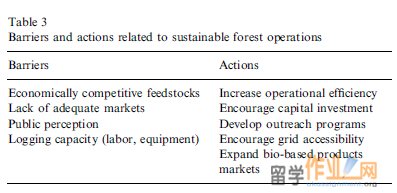 Policy, as identified by this focus group, should be developed that promotes capital investment. Education should be directed toward policy makers, utilities, and the coal industry, and programs should focus on the benefits of using biomass resources along with traditional resources. This group also stressed the importance of increasing the efficiency of forest operations to make forest biomass resources more attractive to all parties mentioned above.
C.A. Mayfield et al. / Biomass and Bioenergy 31 (2007) 631–637
4.3. Critical component 3: product delivery logistics
Efficiency, both economical and operational, transportation laws, and adequate information related to the benefits of biomass production and consumption were key barriers identified by the Product Delivery Logistics focus group (Table 4).
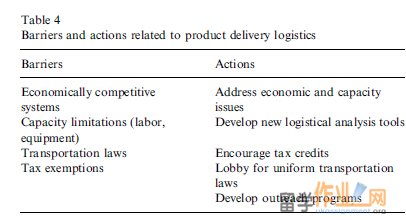 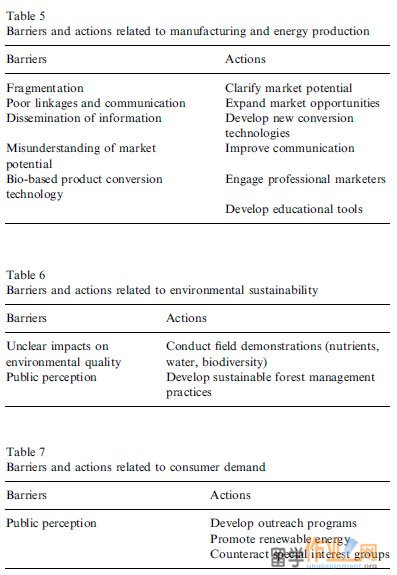 Current conditions in the transportation sector make it difficult to make a profit while transporting a low-value, low-density product. Also, transportation laws can be different on local, state, and federal highways. Being aware of all laws can be challenging. And lastly, there is a lack of information available to legislators and the general public related to the benefits of biomass production and consumption. Actions to be taken included addressing efficiency, education, and uniform transportation laws. Improving logistical efficiency will make forest biomass resources more competitive relative to other energy resources. Improved efficiency can be achieved through new research, development of new software systems, and the passage of uniform transportation laws. Educational programs should be developed to inform consumers about the benefits of biomass production and consumption.
4.4. Critical component 4: manufacturing and energy production
The Manufacturing and Energy Production focus group identified communications and market potential as barriers (Table 5). The group felt that the market potential for forest-based bioenergy was not clearly understood by all sectors of the energy industry. Lack of communication was also noted among other all sectors. Action items included new marketing opportunities and increased and improved communications across sectors. Energy industries, communities, landowners, forestry councils, and others involved in the production of forest biomass, bioenergy, and bio-based products should be made aware of the market potential. Currently, there is no clear understanding of this market potential. The energy grid should also be more accessible to biomass products. Also, information should be shared across all these sectors to facilitate better communication and collaboration. Table 4 Barriers and actions related to product delivery logistics Barriers Actions Economically competitive Address economic and capacity systems issues Capacity limitations (labor, Develop new logistical analysis tools equipment) Transportation laws Encourage tax credits Tax exemptions Lobby for uniform transportation laws Develop outreach programs
4.5. Critical component 5: environmental sustainability
The Environmental Sustainability focus group identified two key barriers: unclear environmental impacts and public perception of biomass removal from the forest, potentially causing environmental degradation (Table 6). Removing biomass from a logging site is seen by many as detrimental to the forest environment. Actions recommended by the workshop included field demonstrations and development of sustainable practices. Field demonstrations that showcase the effects of biomass removal should be conducted for landowners and forest managers. Also, educational programs should be developed and conducted on how to integrate sustainable forest management practices into individual forest operations.
4.6. Critical component 6: consumer demand
The only barrier identified by the Consumer Demand group was public perception (Table 7). People are simply unaware of the benefits related to biomass production and consumption. While people are aware of renewable energy and even bioenergy, they are not aware that forest biomass can be a realistic source of feedstocks for the production of energy. Table 5 Barriers and actions related to manufacturing and energy production Barriers Actions Fragmentation Clarify market potential Poor linkages and communication Expand market opportunities Dissemination of information Develop new conversion technologies Misunderstanding of market Improve communication potential Bio-based product conversion Engage professional marketers technology Develop educational tools Table 6 Barriers and actions related to environmental sustainability Barriers Actions Unclear impacts on environmental quality Public perception Conduct field demonstrations (nutrients, water, biodiversity) Develop sustainable forest management practices Table 7 Barriers and actions related to consumer demand Barriers Actions Public perception Develop outreach programs Promote renewable energy Counteract special interest groups
C.A. Mayfield et al. / Biomass and Bioenergy 31 (2007) 631–637 Actions included developing outreach programs, working with other renewable energy groups, and counteracting special interest groups. Outreach programs, targeted toward the general public, should inform individuals of the benefits of using forest biomass resources for bioenergy and bio-based products. As a whole, the renewable energy sector (wind, water, solar, biomass, etc.) should work together to promote renewable energy. Many times these sectors are seen as competing against one another. With that in mind, other special interest groups (coal, petroleum, etc.) will continue to dominate the energy market.
4.7. Critical component 7: rural economic development
Lack of information, infrastructure, and competing interests were identified as barriers by the Rural Economic Development focus group (Table 8).
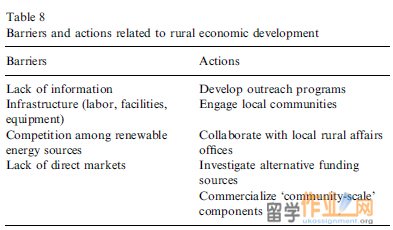 Community leaders are not aware of the opportunities to be gained from the development of forest bioenergy. These same communities are often approached by many different interests competing for their support and development in the area. Also, many communities lack the infrastructure to support large-scale development of the bioenergy industry. Actions recommended to reduce the negative impact of these barriers included outreach programs, local engagement, and working with rural development offices. Working with local communities will be key to the successful development of this industry in rural America. Educating and engaging these communities early in the process is a crucial component. Educational programs should be developed that can help community leaders conduct feasibility studies before jumping in ‘head first’ into a development project. Also, information must be placed into the hands of local, state, and national rural affairs leaders about the opportunities that development of the forest biomass industry can hold in store for rural communities in the rural Southern United States. Incentives should also be available to help in create the infrastructure needed to support the development of the forest bioenergy industry in the rural South. Table 8 Barriers and actions related to rural economic development Barriers Actions Lack of information Develop outreach programs Infrastructure (labor, facilities, Engage local communities equipment) Competition among renewable Collaborate with local rural affairs energy sources offices Lack of direct markets Investigate alternative funding sources Commercialize ‘community-scale’ components
4.8. Common themes across the value chain
Six common themes emerged from the conference. They include (1) marketing, (2) infrastructure, (3) community engagement, (4) incentive support, (5) collaboration, and (6) education. In order to capitalize on the support and enthusiasm and overcome the barriers identified, progress should be made in each of these themes in the near future. #p#分页标题#e#
4.9. Marketing
Markets for bioenergy and bio-based products must be developed. Even with significant gains in the areas of research, development, and education, the biomass industry will not be successful without a market outlet to utilize the final product. New technologies that allow modular generators at the community scale to use forest biomass should be developed. This will broaden the market for forest-based bioenergy beyond utility companies and open it up to rural communities and individuals. Industry also needs a better understanding of the availability of local and global markets. A better understanding of the market potential will allow for more focused marketing efforts and will also allow for more focused research and development efforts. The forest bio-based products industry should work with the renewable energy industry, existing energy providers, and consumer marketing groups to develop markets for bioenergy and bio-based products. The forest products industry can gain insight and achieve greater success by working with these groups rather than working against them in developing new energy markets.
4.10. Infrastructure
Infrastructure development was discussed as a common priority by two seemingly different focus groups, transportation and economic development. As related to transportation, the infrastructure needs to be logistically configured to include delivery of biomass products in conjunction with other timber products. For example, industry should work to create a system in which biomass can be transported along with traditional timber products in order to reduce the cost of biomass transportation. Transportation laws should also be revised to encourage the development of a viable forest biomass industry. As an example, there are industries that are exempt from some transportation laws in order to promote the development of industry. The same should be done for the bioenergy industry. In relation to economic development, the infrastructure of many rural communities must be fully developed to capitalize on the benefits to be gained from the utilization of forest biomass. The infrastructure necessary to facilitate a bioenergy refinery does not presently exist in many rural communities. Industry and rural communities should work together to ensure that infrastructure is in place to support production and
C.A. Mayfield et al. / Biomass and Bioenergy 31 (2007) 631–637 utilization of bioenergy and bio-based products before projects are fully developed.
4.11. Community engagement
The most prevalent theme identified by the economic development focus group was that of community engagement. The group recognized that without community support these projects will never be successful. Without the support of local politicians and citizens, projects are likely to be unsuccessful. Concurrently, support from local leaders can do much to ensure the success of the project. Communities should be engaged early in the development process to ensure a successful relationship between the biobased product industry and local residents.
4.12. Incentive support
Incentives were also identified by several focus groups. The groups identified incentives as being important for research, industry, producers, and consumers. Types of incentives ranged from tax credits to capital investment. Researchers, industry representatives, producer groups, and consumer groups should work together to support and encourage incentives that foster bio-based products development and use.
4.13. Collaboration
Collaboration was identified as an important issue in relation to the energy industry, government, other biomass producers, academic institutions, local communities, and among all players involved in the seven components of the value chain. Everyone seems to be active in separate bioenergy and biomass production areas, yet not everyone communicates with the other parties. Along with information sharing, collaboration allows for more efficient use of limited resources, cohesion among the industry, and the ability to prevent ‘‘reinventing the wheel.’’ Valuable research is being done in many different areas by many different people. Many times, the same research is being done by more than one person or group of people with little collaboration and the results are not being shared across all sectors. Researchers from all sectors, private, government, and academic, should collaborate on research projects to make the best use of limited resources. A viable method of information sharing should also be created to allow greater access to available information.
4.14. Education
Along with collaboration, lack of adequate educational materials and programs was a concern expressed by all of the focus groups. Lack of quality information relating to forest biomass has left potential consumers, likely partners, and forest landowners with a vague understanding of the forest biomass industry. Effective educational programs that will provide biomass information to forestry professionals, energy professionals, economic developers, and the general public need to be developed. Only by generating an interest among these individuals and groups will the industry be able to fully realize its potential. Programs should focus on promoting forest biomass as a clean, environmentally friendly renewable natural resource.
5. Summary and conclusions 总结和结论
Using forest resources to create bioenergy and bio-based products in the Southern United States is a viable option for increasing value to the forest landowners, providing a renewable natural energy source, and providing needed economic development for many southern communities. The forest biomass industry has strong support and enthusiasm from all aspects of industry. Forest products personnel, energy industry personnel, and economic development specialists agree that forest biomass has a large potential for contributing to solutions to many southern problems. Yet, all agree that a lack of cohesion, a lack of collaboration with other biomass producers, a disconnection with the energy industry, and a lack of quality information related to forest biomass are significant barriers to be overcome. While six common themes related to technical and nontechnical barriers were identified by all focus groups, it is important to remember that each group also identified specific actions for their respective components of the value chain. These six common themes (marketing, infrastructure, community engagement, incentives, collaboration, and education) have the potential to make large impacts on the forest bio-based products industry. Forest industry, the energy industry, academia, extension personnel, and rural communities should collaborate to support research, policy issues, and educational programs that enhance the efficiency of current forest biomass operations and promote the use of forest biomass for bioenergy. Action from these individuals would be an important step in ensuring that the development potential of the forest biobased products industry is realized.
Acknowledgments 致谢
The authors would like to acknowledge Texas Cooperative Extension, Texas A&M University, US Department of Energy, USDA Forest Service—Southern Research Station, Southern Forest Research Partnership, Texas Industries of the Future, Green Mountain Energy, Southern Group of State Foresters, Texas Forestry Association, Southern States Energy Board, and Texas Renewable Energy Industries Association for their participation and support of the conference. Funding for the conference was provided by US Department of Energy Grant no. DE-FG1-02EE65000.
C.A. Mayfield et al. / Biomass and Bioenergy 31 (2007) 631–637
References 文献
[1] Wear DN, Greis JG, editors. Southern forest resource assessment. General Techical Report SRS-53. Asheville, NC: US Department of Agriculture, Forest Service, Southern Research Station; 2002. 635p. [2] USDA Forest Service. Potential damage due to Hurricane Katrina in Mississippi, Alabama, and Louisiana—September 22, 2005. Knoxville, TN: US Department of Agriculture, Forest Service, Southern Research Station, Forest Inventory and Analysis; 2005. 2p. [date accessed: October 10, 2005]. [3] Texas Forest Service. Hurricane Rita timber damage assessment. College Station, TX: Texas Forest Service; 2005. 7p. [date accessed: October 10, 2005]. [4] Price T, Doggett C, Pye J, Smith B. A history of southern pine beetle outbreaks in the Southeastern United States. Atlanta, GA: Georgia Forestry Commission; 1998. [5] USDA Economic Research Service. [date accessed: August 25, 2005]. [6] Abt KL, Winter SA, Huggett Jr RJ. Local economic impact of forests. In: Wear DN, Greis JG, editors. Southern forest resource assessment. Asheville, NC: United States Department of Agriculture, US Forest Service, Southern Research Station; 2002. p. 239–67. [7] Gan J, Smith CT. Co-benefits of utilizing logging residues for bioenergy production: the case for East Texas, USA. Biomass and Bioenergy. 2007, in press, doi:10.1016/j.biombioe.2007.06.027. [8] Richardson J, Bjo. rheden R, Hakkila P, Lowe AT, Smith CT, editors. Bioenergy from sustainable forestry: guiding principles and practice. Dordrecht, The Netherlands: Kluwer Academic Publishers; 2002. 344p.
|
 |
|||
| 网站地图 |

